Short- and Long-Term Outcomes of Community-Based Art Education among Students in Higher Education
Abstract
1. Introduction
In a funding environment that prioritizes short-term demonstrable results, the majority of participatory arts and media evaluation happens during and just after a project has taken place. There is little incentive to build a picture of the long term impact of initiatives and a dearth of research that considers how the effects of participatory arts and media projects play out over time [15].(p. 182)
- What are the immediate cognitive, social, and emotional outcomes associated with participating in a community-based art project for college students?
- How do those outcomes change over time?
2. Theoretical Framework
[A]ffective and social aspects of development are generally considered in examining curricula intended for young children. Affective and social neuroscience findings suggest, however, that emotion and cognition, body and mind, work together in students of all ages. Future research and theory in education should attempt to understand how best to characterize and capitalize on the emotional and social dimensions of learning in older students, including adults, keeping in mind what is known of the biological underpinnings of these processes [33].(p.102)
Community-based art education is primarily about fostering asset-focused, community-based teaching and learning experiences with and through art. Community based art education takes place in both educational institutions and communities. It provides opportunities for participants to develop art skills while learning from one another about their community as situated in the larger context, and by building meaningful connections through artistic collaborations that inspire personal, social, and communal transformation [46].(p. 206)
3. Methods
4. Results
- The students’ sense of community was greatly broadened within the class and beyond. One student commented, “it was just a nice way to open the door for all of us to be a part of the community, even if we aren’t like fully a part of it and we don’t live there, it’s nice to know that we have contacts, where we can not only keep in contact with them but they invite us to things and we feel welcomed as a member.” (findings from the end-of-course focus group).
- Students felt more connected to, and empathetic toward, the people of Trenton, which shed light on their own experiences, personal histories, and preconceptions. At the beginning of the course, students expressed many concerns about Trenton’s reputation as a hot spot for crime and drug activity, but over time students’ perceptions became more empathetic, shifting toward seeing the situation through individual’s experiences rather than statistics: “When someone [who may be under the influence of drugs or alcohol] comes up to you it is scary at first, but then you have to take a step back and ask what is this person going through. It’s a humanizing experience.”. One student described a parallel situation in the area she grew up and how her experiences helped her understand neighboring communities that had a bad reputation: “Growing up in that community and then coming here and seeing that there was the same kind of relationship and then getting to be involved in that community makes me a lot less afraid to also interact with the communities near me in a similar way. It’s not just this one place that this stereotype exists, I think this stigma is placed on a lot of places. I think you can learn from that and apply it to other things and other parts of your life. That might spread the love a little bit, so I think that was important.” Ultimately, students were pleased to be able to change the narrative by contributing to positive media messages about Trenton through the local media attention the projects received (findings from the end-of-course focus group) (See Figure 4).
- 3.
- This interpersonal interaction led to a much higher personal investment in the outcome of the projects and internal motivation to complete them. The group consensus was that not wanting to let the community partners down, not grades, was the primary motivating factor. According to one student, “There were other people counting on you to have the garden mural done and like, you know, the worst thing is hearing ‘I’m disappointed.’ That is the worst thing. So having other people who you really don’t know disappointed in you, as not only an artist but as a person too, it’s like oh my god, this is devastating. You have to get it done for the sake of others, not just yourself…. That woman with the heart on her house, imagine being like ‘sorry we couldn’t get it done, I didn’t feel like coming in.’ Just thinking about so many people who were really so happy to have the opportunity to have us do this, we’re not just letting them down, we’re letting all the people that wanted them to do it, all the people that lived there.” Students expressed appreciation for the contextualized nature and the hands-on nature of the projects. One student reported, “I think the hands on…if we had just read about community art, and just read the real examples from the text you had us read, we would have all been like this is a great idea, probably would have never gone anywhere, but now that we’ve all done it, it’s like, ‘Let’s do it.’” (findings from the end-of-course focus group) (See Figure 5).
- 4.
- Students were able to apply academic theory in concrete ways, demonstrating not only application of content, but also transfer. Students described specific ways they the course impacted their plans for the future. One said, “I applied [my learning] elsewhere, I went to a school on my own and did some paintings on blacktops for kids, it was fun.” Another said, “My goal for the summer is to make a master calendar of all the different non-profit volunteering events for my high-school students at high-west because I think, what I learned most about was what all the different non-profits, and the works that they do in the city and my students don’t know anything about that… So that’s my goal this summer, to get my students involved with all the different non-profits.” Another said, “Actually the grant that [we] created --the painted planter idea--I submitted to my town. I’m doing it this summer…I’ll get $500, the hardware store is donating wood to it, and I’ve already put the kids to work in one summer program. They’re pumped. I’m pumped….Kids each get a piece of wood, they can decorate them however they want, and then we put it together in a planter, and then we plant herbs in them…” (findings from the end-of-course focus group).
- 5.
- Students experienced a sense of personal growth, taking major steps towards new competencies. For example, one student commented, “Looking back on the visual journal, and reading everything that I had wrote, I grew so much as a person and how I viewed Trenton in the best way possible. So it’s nice to look back on that and see how I thought at one point and how I didn’t think we would come this far.” Another said, “I remember telling someone at home about how the class was going, they were just like ‘I can’t believe you’re going there’… yeah I’m going there. I’m actually doing such positive things I never thought I could do on my own.” Collaborating artists confirmed this observation, stating “it was cool to see—to watch you guys grow up before our eyes.” (findings from the end-of-course focus group).
- 6.
- Students were able to articulate ways in which their learning grew and changed from the very first days of class to the final result, demonstrating a metacognitive perspective on their own learning. After connecting some of their learning with content from other courses including Maslow’s hierarchy of needs and their research on Confucius’s perseverance, one student commented, “I don’t want to sound super philosophical but you don’t plant seeds to see the tree. You plant seeds for your children to see the tree, or your grandchildren. It’s not for you.” Another concluded, “The thing I learned from all of this is that what we do may not impact everyone else, but it has impacted each and every one of us to do this elsewhere.” (findings from the end-of-course focus group).
D: The whole problem, well, for me– we were just talking about this before, like, yesterday. The whole problem with artmaking, me being a fine arts major and me graduating, like, in a couple weeks. The biggest problem is that a lot of artists don’t know how to work with other people, they don’t know how to compromise with other people, and they don’t know how to talk to other people in a way that can benefit everyone. So, a collaborative effort, a group project like this where everyone has to put in their piece, everyone has to compromise, everyone has to do the extra step to help other people makes a big difference, especially socially, which is a really important skill to use, especially when you’re going out, having a career even as an artist—especially as an artist, because you have to make those connections or it’ll be very difficult for you to be able to say your piece.PI: So, again, that collaborative aspect.C: I also think in terms of studio versus this kind of thing is you are more invested because it’s not just going up for a critique and then you’re putting it away. It’s got a goal, it’s for somebody. It isn’t for you. Which is nice.A: Yeah.D: It’s bigger than you.C: Yeah.E: That’s exactly what I was thinking, that it’s bigger than me. Because, usually, my art, I just make it alone, and then it goes in a critique, then it goes in my bedroom–A: It goes in my cubby–E: Or my basement. There’s a whole little graveyard of all my giant big paintings that I put in my basement that I still haven’t put in my house yet. This—our mural—is on display. People actually get to see it. Like, instead of my studio paintings usually get hidden away or…A: Not even. I throw literally all of mine out. I have nowhere to put it all anywhere in my house so I just take pictures and leave it here and then people here clean out the studios and I’m, like, sad. I’ll keep what I want, really.E: Yeah.C: And even conceptually. Because when you’re making a work for yourself about personal themes it’s for you, but when you’re doing this kind of thing you have to think about what you’re trying to get at for other people.A: Yeah.C: So you have to think about the whole theme of it entirely differently.(findings from the focus group one-year later)
B: Seriously, the art community there is crazy. Because I also had one of my placements in the Trenton 9th Grade Academy and our co-op, me and F’s co-op, basically lives at the Trenton Coffee Roasters and is super tight with [one of our partner artists] and we went there one day during our fourth block off and took selfies and sent it to him. And it’s crazy to think about the fact that there’s people in the educational community in art and also in just the fine arts community that are connected. I mean, that’s totally off topic, but to answer your question about it in relation to other classes, I think that one of the important parts is that when we’re in classes we hear about other artists and we hear about super crazy people that are, you know, billionaires that are living their lives and having a wonderful time. And, like, yay that’s good for them, but it’s nice to see and to talk to artists that are making really cool work that are normal people that are down the street from you. And you think, ‘yeah I could do this too, and you’re cool, and we can talk about it, and we can stay in contact.’ Which, like, we have and I think that’s a really interesting element that is so not part of other classes.C: Yeah, I think that’s one of the strongest parts of this class, that it was, like, this is the only class that I’ve heard of a local artist, somebody more accessible to me. It’s always just like–B: ‘Go to New York,’ like, yeah right. OkC: Yeah right.D: And, of course, New York is “accessible” for us, but yeah, it’s literally next door neighbors instead.C: Yeah. It just made it a lot easier to connect with real artists, not that we’re not, but, like, established–PI: Professional?C: Yeah, professional. Because otherwise we just look up people online and we don’t have a true connection to them at all.A: Yeah.C: But meeting with them, and seeing them, and hearing from them was such a different…A: Watching their artmaking process.C: Yeah that was a whole different level of knowledge.(findings from the focus group one-year later)
“Going back to that idea of breaking down boundaries together, if you’re doing it alone it would be a lot more threatening, but we’re all, kind of– at least most of us—we’re all kind of going into a very new experience together. It made it easier and we also could, like, bond over it. It was nice because we got to know the people in Trenton and we got to know each other better. The artwork was collaborative and the experience altogether was collaborative between us and the community. There were just a bunch of themes that kind of carried out through all of it that were very good, social things. You know what I mean? I just feel a lot more comfortable around people here, people there, people everywhere.”.(findings from the focus group one-year later)
5. Discussion
It grows out of the artist’s active listening and empathetic identification, and a willingness to let the community influence art and artists. The art and its meaning occur outside the mind of the artist, and develop in the exchange between the artist and viewers, ultimately effecting the identities of both [58].(p. 4)
6. Conclusions
Funding
Institutional Review Board Statement
Informed Consent Statement
Data Availability Statement
Conflicts of Interest
References
- Lowe, S. Creating Community: Art for Community Development. J. Contemp. Ethnogr. 2000, 29, 357–386. [Google Scholar] [CrossRef]
- Stephenson, M. Developing Community Leadership through the Arts in Southside Virginia: Social Networks, Civic Identity and Civic Change. Community Dev. J. 2005, 42, 79–96. [Google Scholar] [CrossRef]
- Thomas, E.; Pate, S.; Ranson, A. The Crosstown Initiative: Art, Community, and Placemaking in Memphis. Am. J. Community Psychol. 2014, 55, 74–88. [Google Scholar] [CrossRef] [PubMed]
- White, M.; Robson, M. Lantern Parades in the Development of Arts in Community Health. J. Med. Humanit. 2015, 36, 59–69. [Google Scholar] [CrossRef]
- Chonody, J. (Ed.) Community Art: Creative Approaches to Practice; Common Ground Publishing: Champaign, IL, USA, 2014. [Google Scholar]
- Kelher, M.; Berman, N.; Dunt, D.; Johnson, V.; Curry, S.; Joubert, L. Evaluating Community Outcomes of Participation in Community Arts: A Case for Civic Dialogue. J. Sociol. 2014, 50, 132–149. [Google Scholar] [CrossRef]
- Rushton, M. (Ed.) Creative Communities: Art Works in Economic Development; The Brookings Institution: Washington, DC, USA, 2013. [Google Scholar]
- Stephenson, M.; Tate, S.A. Arts and Community Change: Exploring Cultural Development, Policies, Practices and Dilemmas; Routelage: New York, NY, USA, 2015. [Google Scholar]
- Clark, G.; Zimmerman, E. Greater Understanding of the Local Community: A Community-Based Art Education Program for Rural Schools. Art Educ. 2000, 53, 4–5. [Google Scholar] [CrossRef]
- Krensky, B. Going on Beyond Zebras: A Middle School and Community-Based Arts Organization Collaborate for Change. Educ. Urban Soc. 2001, 33, 427–445. [Google Scholar] [CrossRef]
- Szekely, G. Shopping for Art Materials and Ideas. Art Educ. 1994, 47, 9–17. [Google Scholar] [CrossRef]
- Bobick, B. Promoting Civic Engagement through University Curricula. In Handbook of Research on the Facilitation of Civic Engagement through Community Art; Hersey, Nanney, L., Bobick, Eds.; IGI Global: Hershey, PA, USA, 2017; pp. 218–236. [Google Scholar]
- Lim, M.; Chang, E.; Song, B. Three Initiatives for Community-Based Art Education Practices. Art Educ. 2013, 66, 7–13. [Google Scholar] [CrossRef]
- Charest, B.C.; Bell, L.D.; Gonzalez, M.; Parker, V.L. Turning Schools Inside Out: Connecting Schools and Communities through Public Arts and Literacies. J. Lang. Lit. Educ. 2014, 10, 189–203. [Google Scholar]
- Fairey, T. Does the Impact of Participatory Arts Endue Over Time? Longitudinal Research and Strengthening the Case for Participatory Arts and Media. In Participatory Art for Invisible Communities; Sertić, I., Ed.; Omnimedia: Zagreb, Croatia, 2019; pp. 181–186. [Google Scholar]
- Arai, S.; Pedlar, A. Moving Beyond Individualism in Leisure Theory: A Critical Analysis of Concepts of Community and Social Engagement. Leis. Stud. 2003, 22, 185–202. [Google Scholar] [CrossRef]
- Brueggemann, W.G. The Practice of Macro Social Work, 2nd ed.; Nelson Thomson Learning: Toronto, ON, Canada, 2002. [Google Scholar]
- Kalin, N.M. The Neoliberalization of Creativity Education: Democratizing, Destructuring and Decreating; Palgrave-Macmillan: London, UK, 2018. [Google Scholar]
- Putman, R. Bowling Alone: The Collapse and Revival of American Community; Simon & Schuster: New York, NY, USA, 2000. [Google Scholar]
- Belsha, K. Stress and Short Tempers: Schools Struggle with Behavior as Students Return. Chalkbeat 2021 Sep 27. Available online: https://www.chalkbeat.org/2021/9/27/22691601/student-behavior-stress-trauma-return (accessed on 15 December 2022).
- Dissanayake, E. Art in Global Context: An Evolutionary/Functionalist Perspective for the 21st Century. Int. J. Anthropol. 2003, 18, 245–258. [Google Scholar]
- Fernández-Navarro, V.; Camarós, E.; Garate, D. Visualizing Childhood in Upper Paleolithic Societies: Experimental and Archaeological Approach to Artists’ Age Estimation through Cave Art Hand Stencils. J. Archaeol. Sci. 2022, 140, 105574. [Google Scholar] [CrossRef]
- Carroll, N. Art and Human Nature. J. Aesthet. Art Crit. 2004, 62, 95–107. [Google Scholar] [CrossRef]
- Dewey, J. Art As Experience; Penguin Group: New York, NY, USA, 1934. [Google Scholar]
- Dissanayake, E. What Art Is and What Art Does: An Overview of Contemporary Evolutionary Hypotheses. In Evolutionary and Neurocognitive Approaches to Aesthetics, Creativity and the Arts; Martindale, C.P., Locher, Petrov, V.M., Eds.; Baywood Publishing Company: Amityville, NY, USA, 2007; pp. 1–14. [Google Scholar]
- Xygalatas, D. Ritual: How Seemingly Senseless Acts Make Life Worth Living; Little, Brown Spark: Boston, MA, USA, 2022. [Google Scholar]
- Fischer, K.W.; Bidell, T. Dynamic Development of Action and Thought. In Handbook of Child Psychology, Vol. 1: Theoretical Models of Human Development, 6th ed.; Damon, W., Lerner, R., Eds.; John Wiley & Sons: Hoboken, NJ, USA, 2006; pp. 313–399. [Google Scholar]
- Immordino-Yang, M.H.; Damasio, A. We Feel, Therefore We Learn: The Relevance of Affective and Social Neuroscience to Education. Mind Brain Educ. 2007, 1, 3–10. [Google Scholar] [CrossRef]
- Immordino-Yang, M.H.; Gotlieb, R. Embodied Brains, Social Minds, Cultural Meaning: Integrating Neuroscientific and Educational Research on Social-Affective Development. Am. Educ. Res. J. 2017, 54, 344S–367S. [Google Scholar] [CrossRef]
- Zeki, S. Inner Vision: An Exploration of Art and the Brain; Oxford University Press: New York, NY, USA, 1999. [Google Scholar]
- Ramachandran, V.S. The Tell-Tale Brain: A Neuroscientist’s Quest for What Makes Us Human; W.W. Norton & Company: New York, USA, 2011. [Google Scholar]
- Iacoboni, M. Mirroring People: The New Science of How We Connect with Others; Farrar, Straus, & Giroux: New York, NY, USA, 2008. [Google Scholar]
- Immordino-Yang, M.H. Implications of Affective and Social Neuroscience for Educational Theory. Educ. Philos. Theory 2011, 43, 98–103. [Google Scholar] [CrossRef]
- Vygotsky, L. The Psychology of Art; MIT Press: Boston, MA, USA, 1971. [Google Scholar]
- Langer, S. Feeling and Form; Scribner: New York, NY, USA, 1953. [Google Scholar]
- Blatt-Gross, C. Casting the Conceptual Net: Cognitive Possibilities for Embracing the Social and Emotional Richness of Art Education. Stud. Art Educ. 2010, 51, 353–367. [Google Scholar] [CrossRef]
- Damasio, A. Descartes’ Error: Emotion, Reason, and the Human Brain; Penguin Books: New York, NY, USA, 1994. [Google Scholar]
- Katz, M.-L. (Ed.) Moving Ideas: Multimodality and Embodied Learning in Communities and Schools; Peter Lang: New York, NY, USA, 2013. [Google Scholar]
- Wilson, A.; Golonka, S. Embodied Cognition is Not What You Think It Is. Front. Psychol. 2013, 4, 58. [Google Scholar] [CrossRef] [PubMed]
- Blatt-Gross, C. Creating community from the inside out: A concentric perspective on collective artmaking. Arts Educ. Policy Rev. 2016, 118, 51–59. [Google Scholar] [CrossRef]
- Wenger, E. Communities of Practice: Learning, Meaning and Identity; Cambridge University Press: Cambridge, UK, 1998. [Google Scholar]
- Felder, R.M.; Brent, R. Cooperative Learning. In Active Learning: Models from the Analytical Sciences, ACS Symposium Series 970; Mabrouk, P.A., Ed.; American Chemical Society: Washington, DC, USA, 2007. [Google Scholar]
- Blatt-Gross, C.E. Connecting the Past and the Present: Using our Deep History of Learning through Community Art to Inform Contemporary Student Engagement. In Handbook of Research on the Facilitation of Civic Engagement through Community Art; Hersey, L.N., Bobick, B., Eds.; IGI Global: Hershey, PA, USA, 2017; pp. 168–192. [Google Scholar]
- Lawton, P.H.; Walker, M.A.; Green, M. Community-Based Art Education Across the Lifespan: Finding Common Ground; Teachers College Press: New York, NY, USA, 2019. [Google Scholar]
- Krensky, B.; Lowe Steffen, S. Engaging Classrooms and Communities through Art: A Guide to Designing and Implementing Community-Based Art Education; Altamira Press: Lanham, MD, USA, 2009. [Google Scholar]
- Lawton, P.H. At the Crossroads of Intersecting Ideologies: Community-Based Art Education, Community Engagement and Social Practice Art. Stud. Art Educ. 2019, 60, 203–218. [Google Scholar] [CrossRef]
- Husserl, E. Ideas: General Introduction to Pure Phenomenology; Gibson, W., Ed.; Original work published 1931; Humanities Press: New York, NY, USA, 1976. [Google Scholar]
- Heidegger, M. Being and Time; Macquarrie, J., Robinson, E., Eds.; Original work published 1927; Harper and Row: New York, NY, USA, 1962. [Google Scholar]
- Merleau-Ponty, M. The Primacy of Perception; Edie, J.M., Ed.; Norwestern University Press: Evanston, IL, USA, 1964. Original work published 1948. [Google Scholar]
- Merleau-Ponty, M. The Visible and the Invisible; Lefort, C., Lingis, A., Eds.; Northwestern University Press: Evanston, IL, USA, 1968; Original work published in 1948. [Google Scholar]
- Merleau-Ponty, M. Phenomenology of Perception; Smith, C., Ed.; Original work published in 1962; Routledge & Kegan Press: London, UK, 1981. [Google Scholar]
- DahlBerg, K.; Drew, N.; Nystrom, M. Reflective Lifeworld Research; Studentlitteratur: Lund, Sweden, 2001. [Google Scholar]
- Knight, K.; Schwarzman, M. Beginners Guide to Community Based Arts; New Village Press: New York, NY, USA, 2015. [Google Scholar]
- Angelides, P.; Michaelidou, A. Collaborative Artmaking for Reducing Marginalization. Stud. Art Educ. A J. Issues Res. 2009, 51, 36–49. [Google Scholar] [CrossRef]
- Walton, G.M.; Cohen, G.L.; Cwir, D.; Spencer, S.J. Mere Belonging: The Power of Social Connections. J. Personal. Soc. Psychol. 2012, 102, 513–532. [Google Scholar] [CrossRef]
- Asch, S.E. Social Psychology; Prentice Hall: Englewood Cliffs, NJ, USA, 1952. [Google Scholar] [CrossRef]
- Maguire, C.; McCallum, R. ArtsAction Group: Fostering Capabilities through Socially Engaged Art. In Bridging Communities through Socially Engaged Art; Wexler, A., Sabbaghi, V., Eds.; Routledge: New York, NY, USA, 2019; pp. 38–47. [Google Scholar]
- Garber, E. Social Justice and Art Education. Vis. Arts Res. 2004, 30, 4–22. [Google Scholar]
- Kester, G.H. Conversation Pieces: Community and Communication in Modern Art; University of California Press: Irvine, CA, USA, 2004. [Google Scholar]
- Halverson, E.R. How the Arts Can Save Education: Transforming Teaching, Learning and Instruction; Teachers College Press: New York, NY, USA, 2021. [Google Scholar]
- Edgar, S.N.; Morrison, B. A Vision for Social Emotional Learning and Arts Education Policy. Arts Educ. Policy Rev. 2020, 122, 145–150. [Google Scholar] [CrossRef]
- The Center for Arts Education and Social Emotional Learning. 2022. Available online: https://artsedsel.org/ (accessed on 15 December 2022).
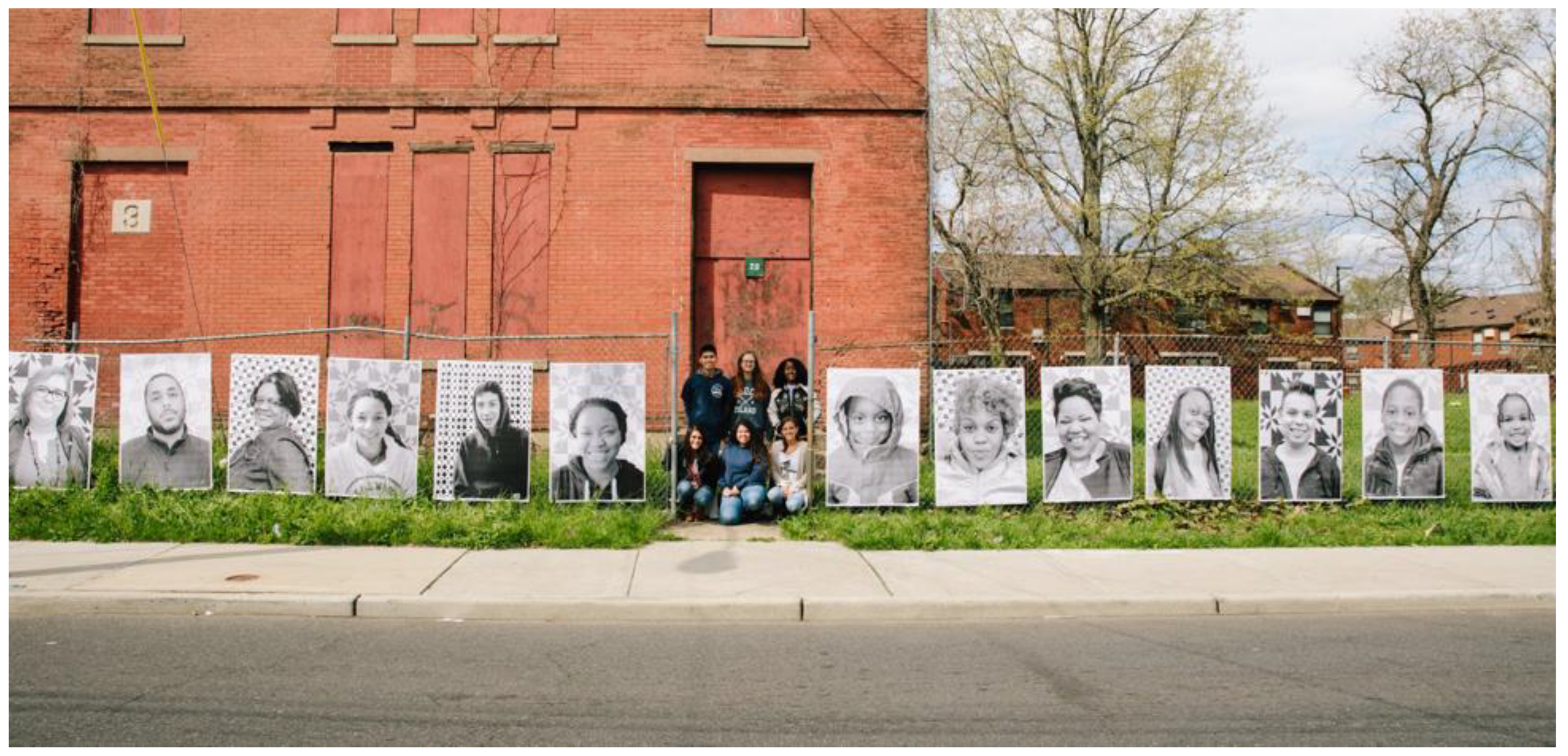
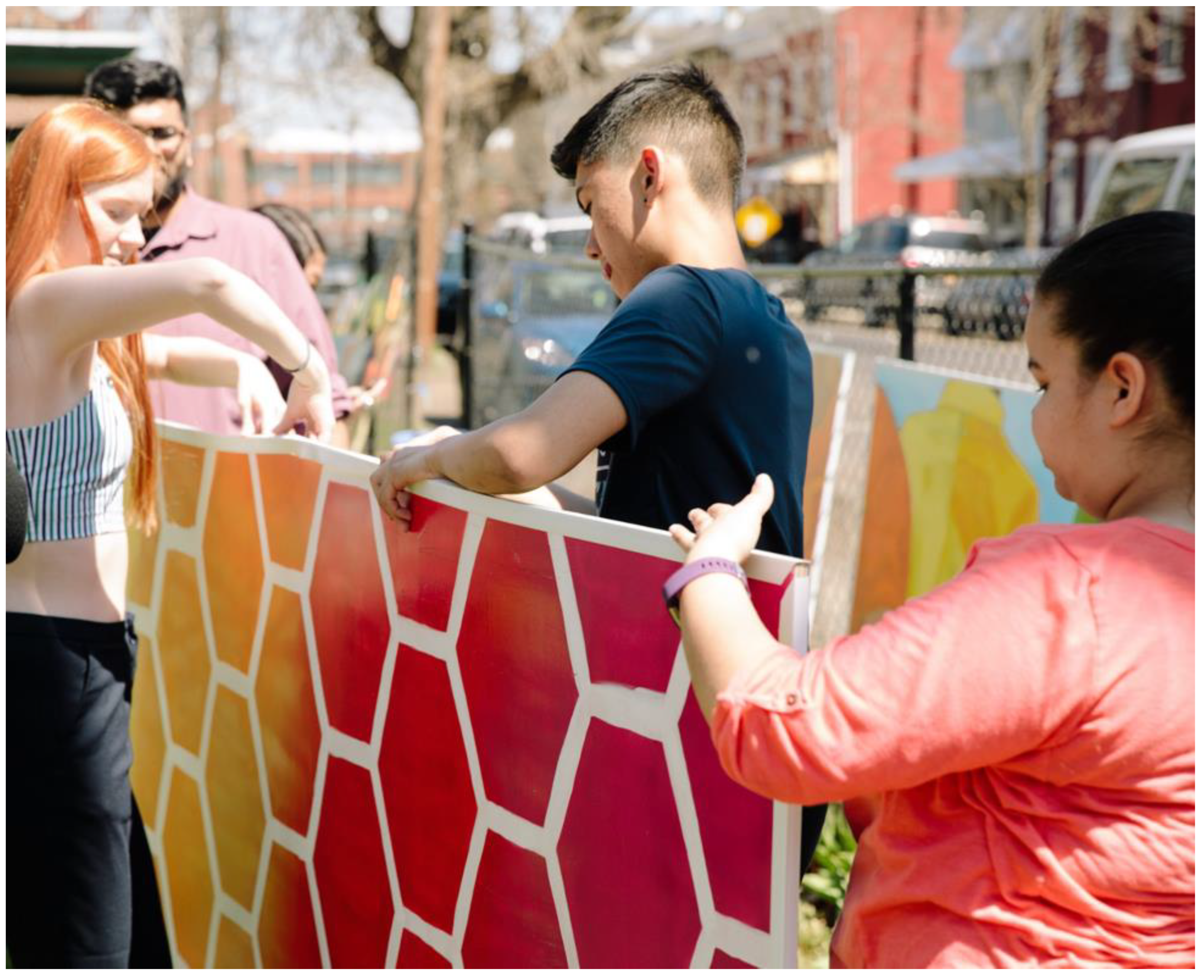
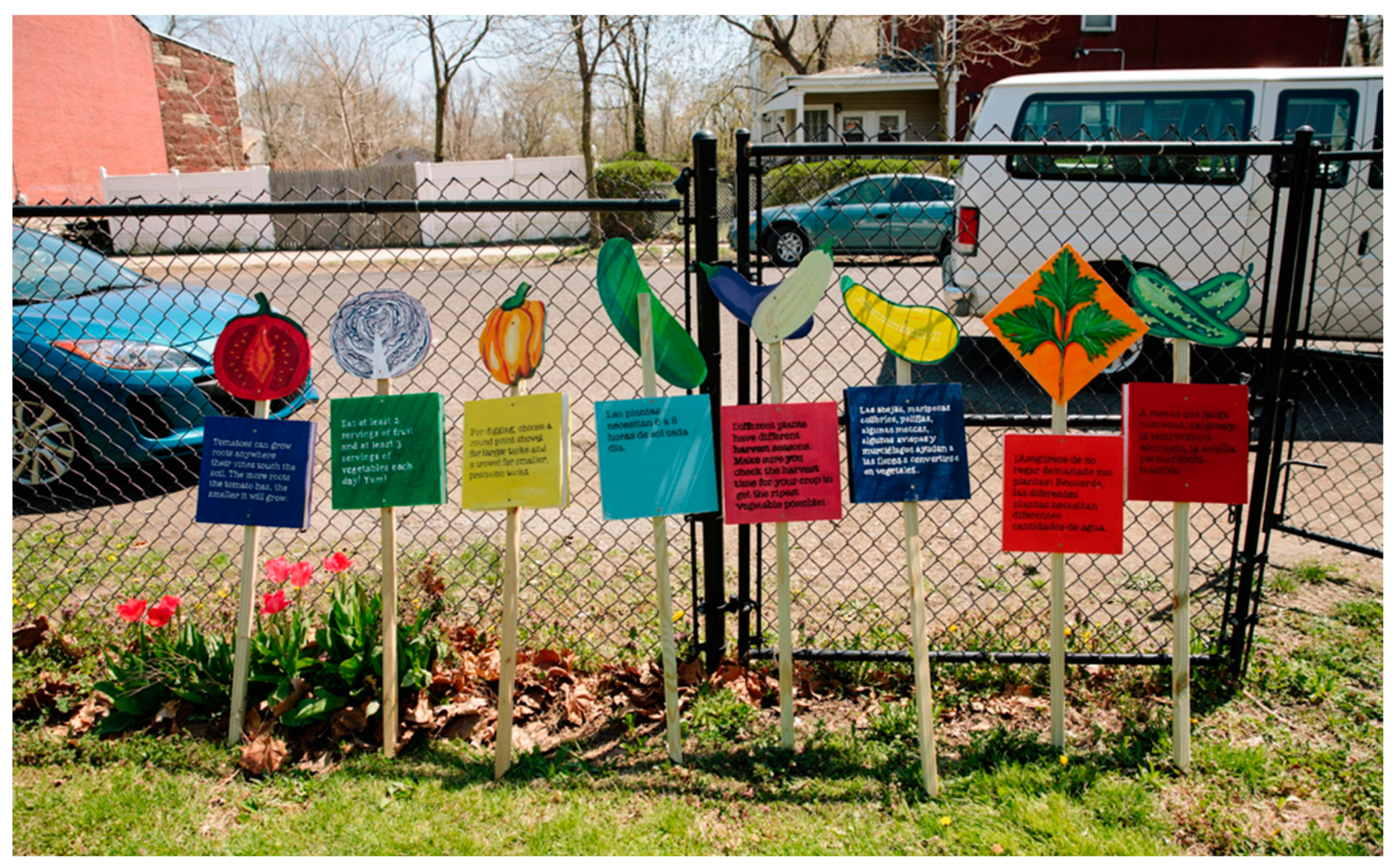
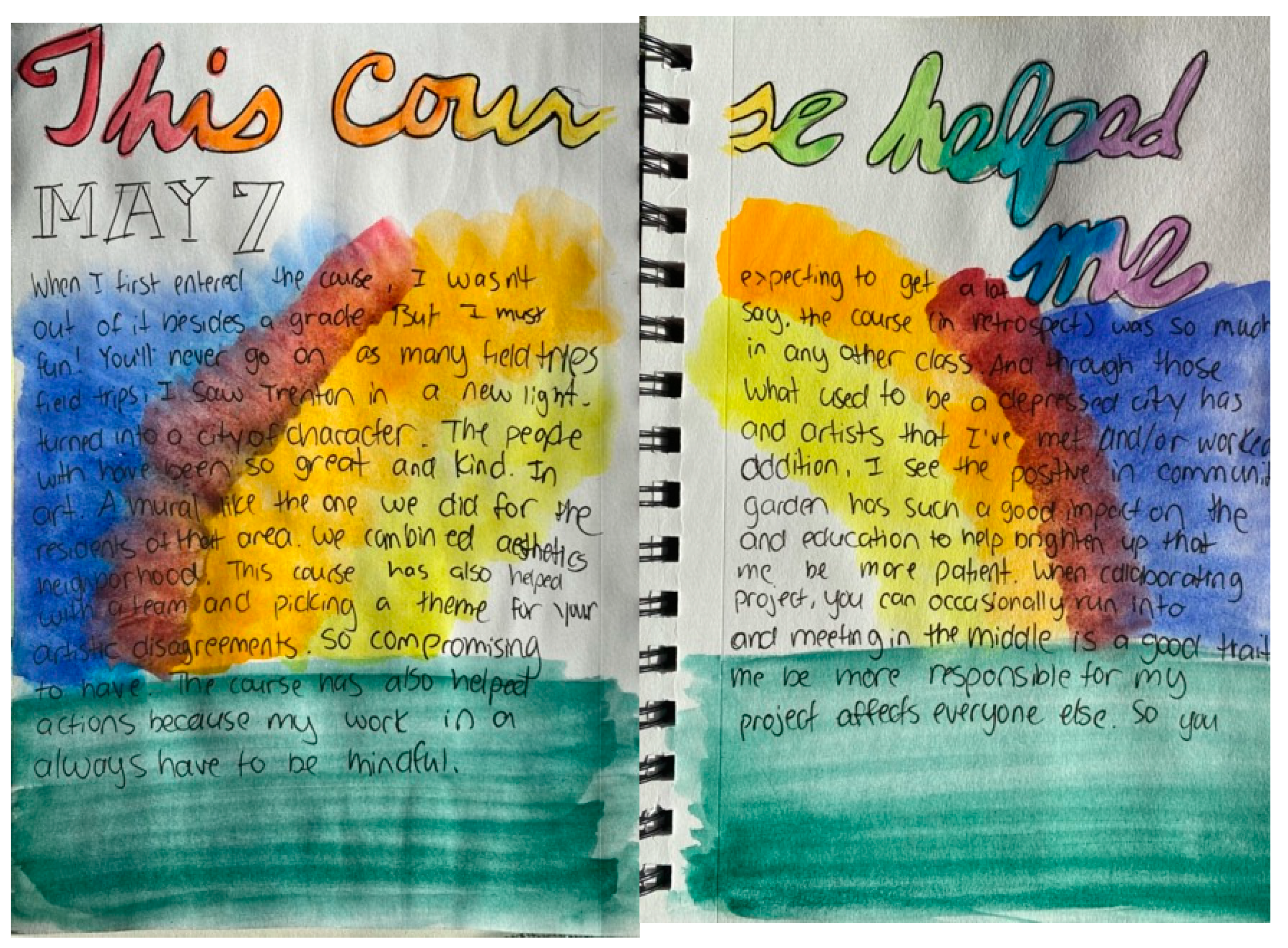
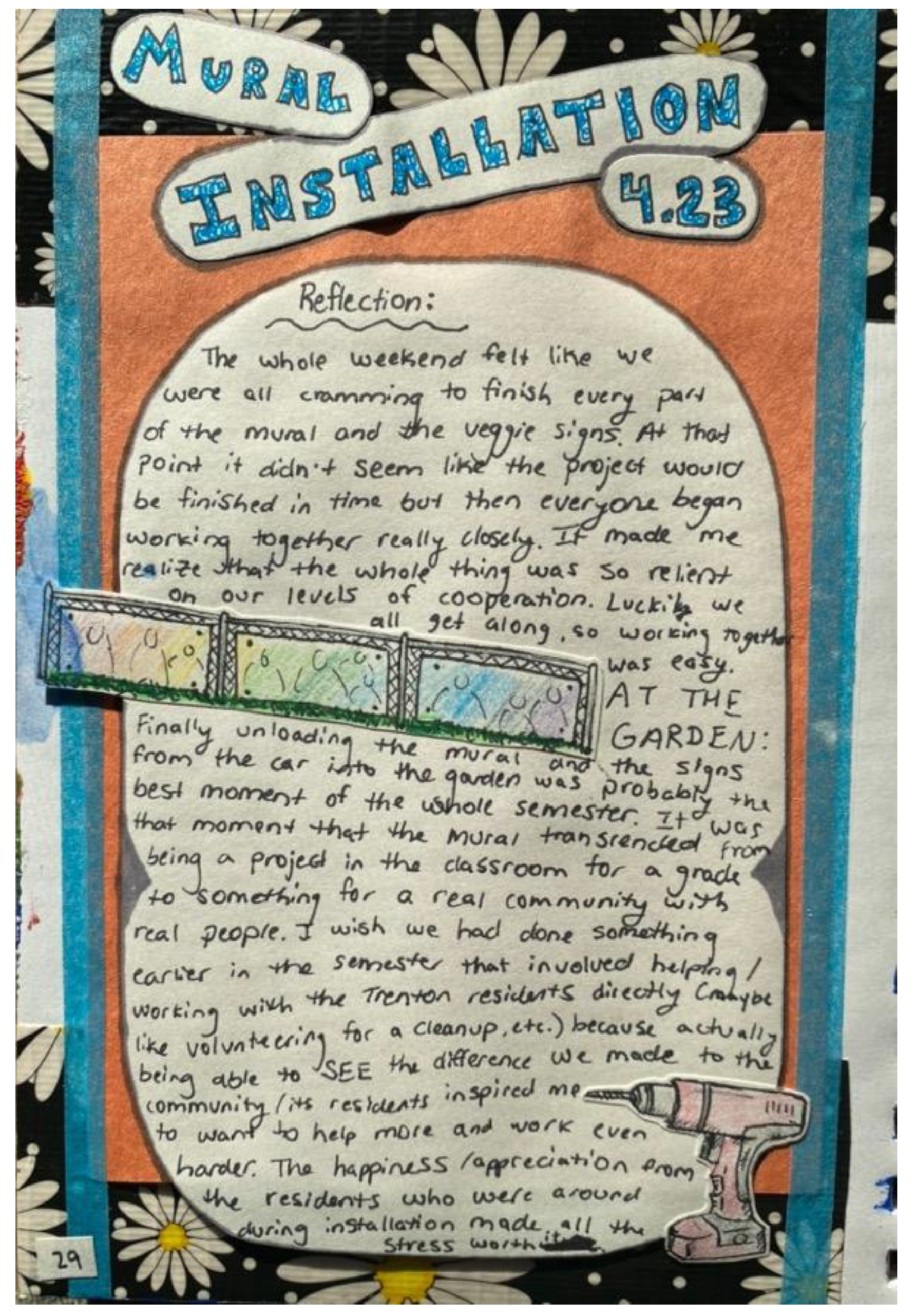
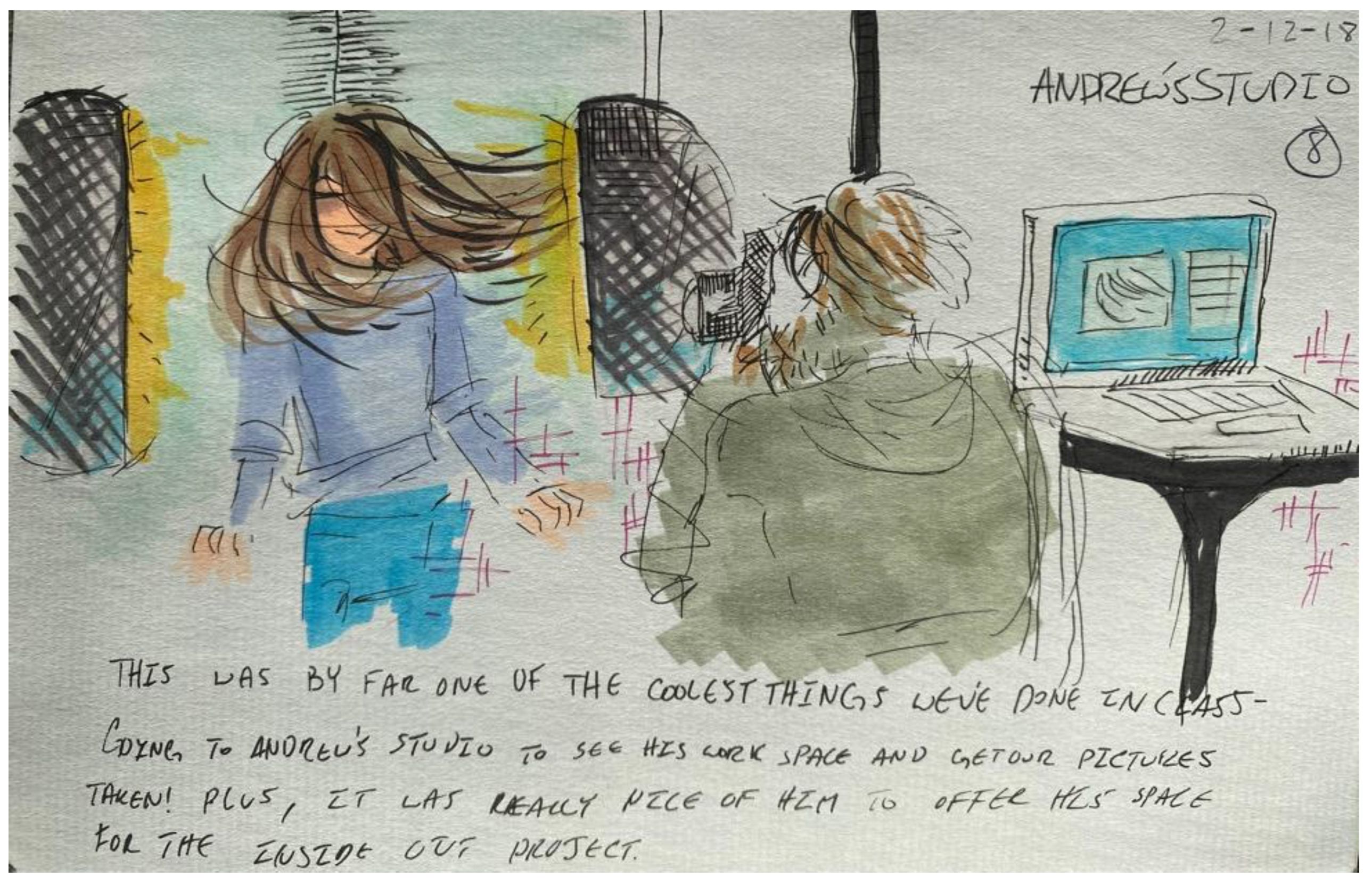
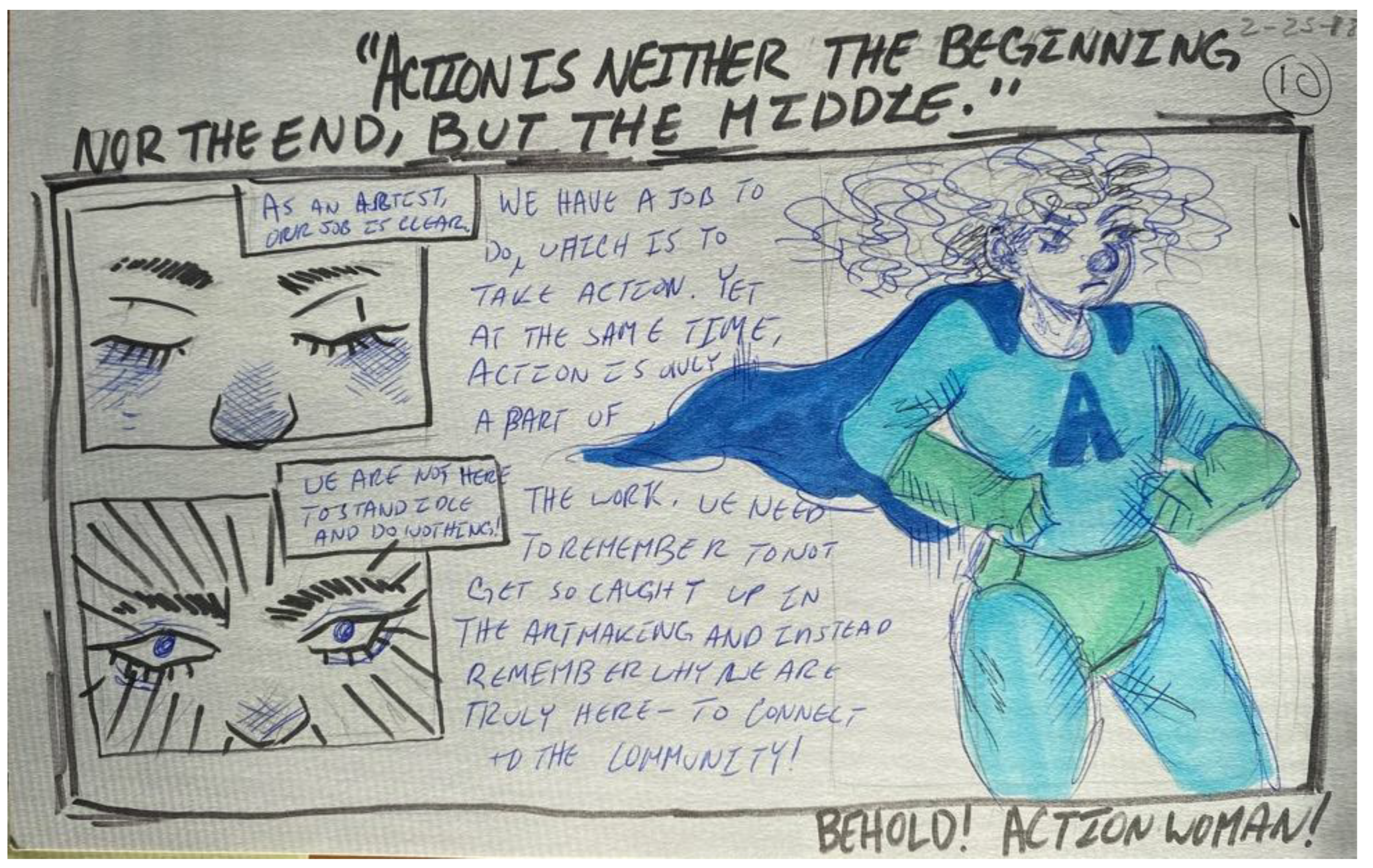
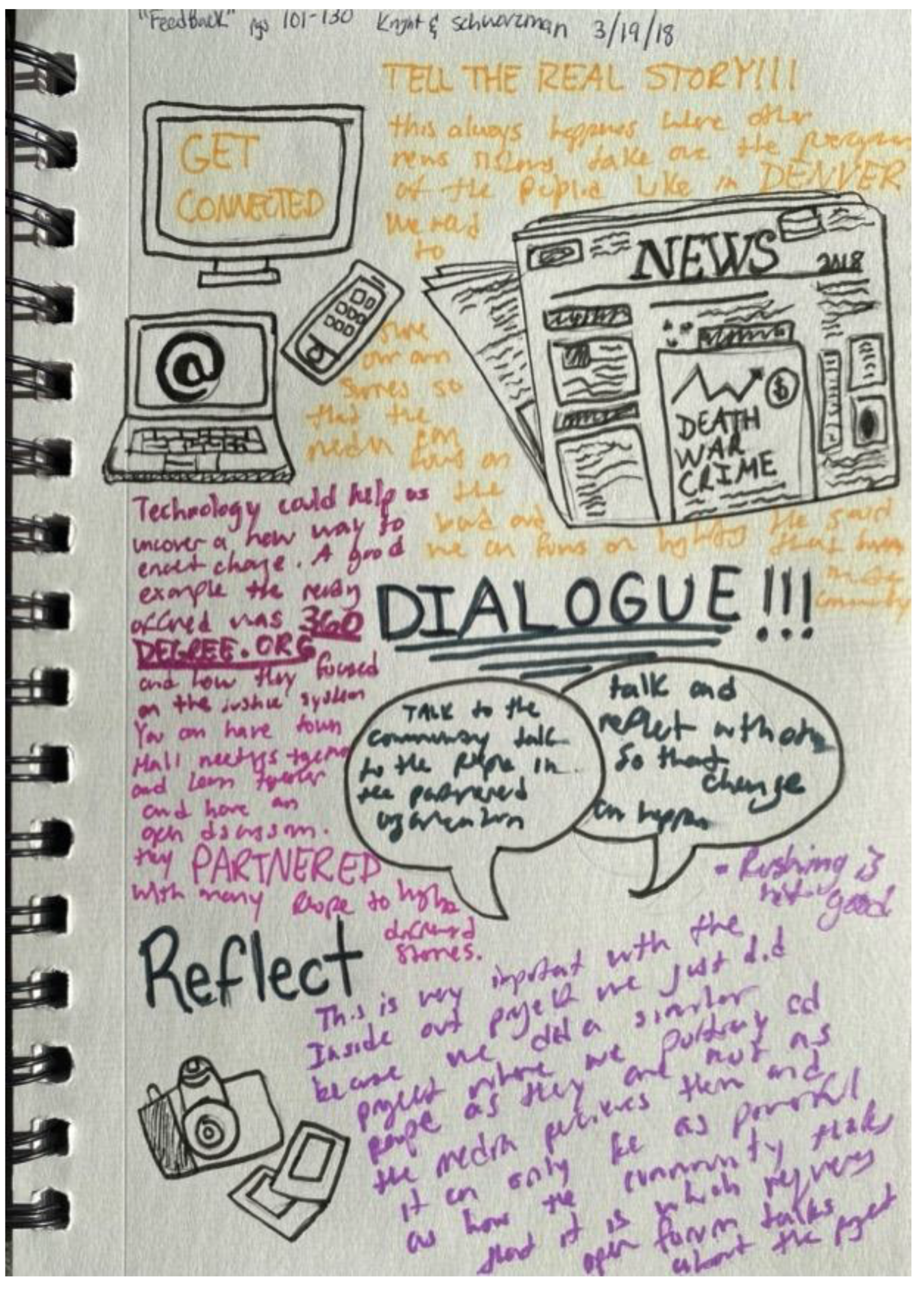
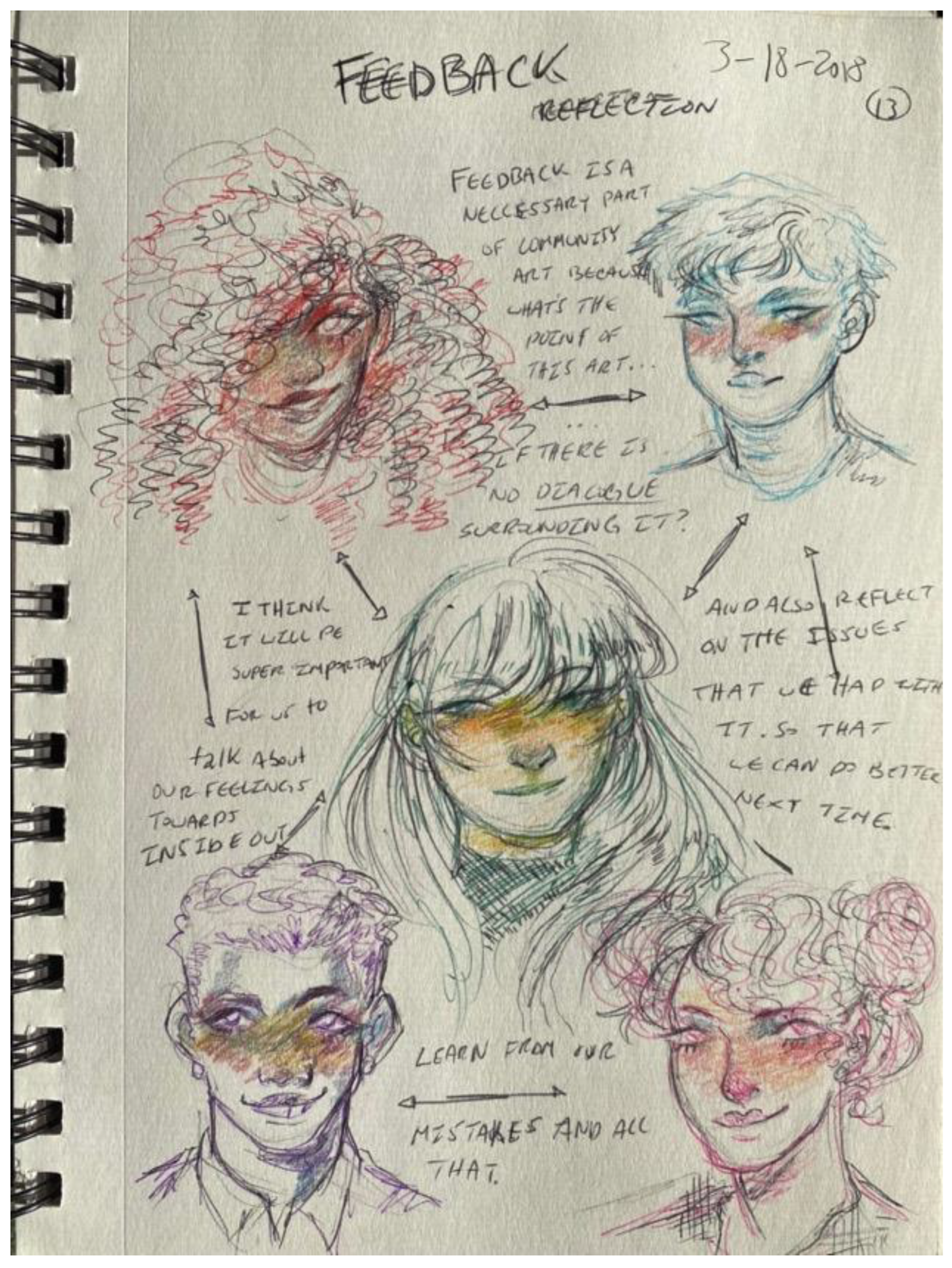
Disclaimer/Publisher’s Note: The statements, opinions and data contained in all publications are solely those of the individual author(s) and contributor(s) and not of MDPI and/or the editor(s). MDPI and/or the editor(s) disclaim responsibility for any injury to people or property resulting from any ideas, methods, instructions or products referred to in the content. |
© 2023 by the author. Licensee MDPI, Basel, Switzerland. This article is an open access article distributed under the terms and conditions of the Creative Commons Attribution (CC BY) license (https://creativecommons.org/licenses/by/4.0/).
Share and Cite
Blatt-Gross, C. Short- and Long-Term Outcomes of Community-Based Art Education among Students in Higher Education. Educ. Sci. 2023, 13, 166. https://doi.org/10.3390/educsci13020166
Blatt-Gross C. Short- and Long-Term Outcomes of Community-Based Art Education among Students in Higher Education. Education Sciences. 2023; 13(2):166. https://doi.org/10.3390/educsci13020166
Chicago/Turabian StyleBlatt-Gross, Carolina. 2023. "Short- and Long-Term Outcomes of Community-Based Art Education among Students in Higher Education" Education Sciences 13, no. 2: 166. https://doi.org/10.3390/educsci13020166
APA StyleBlatt-Gross, C. (2023). Short- and Long-Term Outcomes of Community-Based Art Education among Students in Higher Education. Education Sciences, 13(2), 166. https://doi.org/10.3390/educsci13020166




